ISSN ONLINE(2319-8753)PRINT(2347-6710)
ISSN ONLINE(2319-8753)PRINT(2347-6710)
K. Surya kumari1,Dr. V. Lakshmana Rao2, KPR Vittal Murty3.
|
| Related article at Pubmed, Scholar Google |
Visit for more related articles at International Journal of Innovative Research in Science, Engineering and Technology
Vijayawada is the commercial capital of Andhra Pradesh. Many of the agricultural produces from the hinter land arrive here for export to various other parts of the state, country and abroad. Vijayawada is surrounded by small hillocks on all sides making it appear as a basin. Vijayawada is also having excellent network of water bodies with Krishna river on the east and Budameru on the west and three canal systems passing through the city. Yet Vijayawada experiences scorching heat with very high temperatures in summer season. The radiation from the surrounding hillocks keep the city much warm even during the night time. The air pollution in the city is increasing because of rapid industrialization and increase in the density of transport vehicles plying in the city as well as the three important national highways passing through the city. With this background Vijayawada is a suitable city for implementation of viable solution through selected plant species. In this article a detailed description of Air Pollution Tolerance Index was given which makes it possible to delinate plant species as sensitive, intermediatory and resistant to air pollution by planting suitable plant species resistant to air pollution along the highways and along the banks of the canals passing through the city as well as in the parks and green belts developed surrounding the major industries around the city. The vegetative cover when increased substantially will provide not only the natural control of air pollution but also reduce the temperature, pumping moisture by evapotranspiration and moderate the climate. The suitable plant species were suggested in this article. This paves way for steps for environmental management to control air pollution and at the same time provides the desired moderation in climate.
Keywords |
| Pollution, Industrialization, Plant species, Destiny of transport, Green belt, Vegetation, Temperature, Moisture, Evapotranspiration, Climate. |
INTRODUCTION |
| Vijayawada is a historical city situated in the geographical center of Andhra Pradesh state. It is on the banks of Krishna river latitude (16 03 11 N) and longitude (80 03 91 E), the climate is tropical with hot summers and moderate winters. The peak temperature reaches 47 c in may – June. While the winter temperature is 20 – 27 c. The average humidity is 78% and the average annual rainfall is 103 cms. Vijayawada gets it rainfall from both the south-west monsoon and north-east monsoon. The topography of Vijayawada is flat, with a few small to medium sized hills. Vijayawada is also a major railway junction connecting all states in the country. The Vijayawada city is the commercial capital of the state of Andhra Pradesh and is the 3rd largest city in the state and the largest city in Krishna District. Vijayawada has a lot of scope for development and urban growth. Vijayawada also has the 2nd highest bus terminal in Asia next only to Chennai. It was inaugurated on 23rd September 1990 and is officially named as Telugu Satavahana Prayana Pranganam. The city of Vijayawada is traditionally the main agricultural market center for krishna basin, is a major commercial centre to a host of wholesale and retail activity dealing in consumer goods like textiles, automobiles and industrial products etc. It is also a major trading place for processed Virginia tobacco, cotton and turmeric. The agricultural commodities produced in this part of Andhra finds its market in Vijayawada both for local consumption and export. Vijayawada is also known for its mango exports generating crores worth turn over anually. |
II. DATA AND METHODOLOGY |
| Physico-Geographical Conditions of Vijayawada Vijayawada is bounded by the Indrakiladri hills on the east and the west, krishna river and budameru river on the south and north respectively. The northern, north-western and south-western parts of the city are covered by a low range of hills, while the central south-western and north-western parts are covered by rich and fertile agricultural lands with three major irrigation canals namely bandar, eluru and rivus. It is nick named Blaze-wada because of its scorching summer heat. The chalukyas of Kalyan dynasty once conquered this place. Vijayawada literally translates as “the place of victory”. Vijayawada is also a center of Andhra politics. Its prominence as a major trading and business center has earned its title “Commercial Capital of Andhra Pradesh”. Rapid Urbanization of Vijayawada Vijayawada has a lot of scope for development and urban growth. The city's population is expected to increase to 16.5 lakh by 2021. With ever increasing population and unprecedented growth of urban area, the city's landscape is undergoing unwanted changes. With urbanization most of the land surface is covered with concrete, asphalt and other such impervious materials. This leads a variety of urban environmental issues like increase in runoff, increase in land surface temperature etc. The city is experiencing more heat than the surrounding rural areas mainly due to lack of vegetative cover. Much of the radiation and heat is reflected from the surrounding hills resulting in high temperatures even in the night. Some people call Vijayawada, otherwise known as Bezwada as Blaze-wada. It was observed that the urbanization in Vijayawada has increased about 5.39% from 1990 to 2009. Increased urbanization may have several impacts on infra structure, energy use and economy of the city. Due to unprecedented growth of urban area the city's landscape is undergoing tremendous changes. The concrete roads and buildings result in more impervious nature. Changes in Vegetative Cover as Revealed by Satellite Imagery Satellite imagery has been well utilized in the natural science communities for measuring qualitative and quantitative terrestrial land cover changes. The researchers identified that urban environments are most dynamic in nature. There is no doubt that human activities have profoundly changed land cover in the Vijayawada city area |
| during the last half century. Land is one of the most important natural resources. The table reveals drastic decrease in vegetative cover from 1973 to 2009. Agricultural area has been decreased by 65.16%. There is an increase in vegetation or shrubs by 135.61%. The reason for this increase in light vegetation is that large amount of agricultural area converted into land for real estate sales, these lands appear as greenery because of the grass grown on them. The air pollution in Vijayawada urban area is on increase because of new industries and increase of vehicular traffic. Role of Vegetation in Air Pollution Vijayawada air is nurtured with natural as well as man made conventional pollutants. Dust, smoke, fumes, gases like sulfur dioxide, nitrous oxide coming from transport of vehicles and industries. A comparative assessment of ambient air quality of Vijayawada, Andhra Pradesh, India for the years 2000 and 2010 was studied by (Anupama Rashmi et.al.,). Continuous mixing transformation and trans-boundary transportation of air pollutants make air quality of a locality unpredictable. The growth of population, industry and number of vehicles and improper implementation of stringent emission standards make the problem of air pollution still worse (Ravindra et.al.,). Sources of Pollution Road: Air pollution has been mainly caused by rapid industrialization, some critics comment on air pollution as “the price of industrialization”. Air pollution caused by automobiles has been described as the disease of wealth. Vijayawada is well connected to the rest of the country by national highways. NH-5, NH-9 and NH-221. Transport by road from Vijayawada to all places of interest is available in the form of APSRTC buses. The graph depicts the number of registration of vehicles in Vijayawada from 2011 to 2013. Above table shows even a detailed growth rates for different types of vehicles from heavy goods vehicles, buses to other small vehicles like cars and scooters. The growth rates were also given in the table. This clearly shows that the vehicles plying on the roads of Vijayawada is increasing rapidly and the air pollution due to transport vehicles is also on the increase. The roads are also in municipal corporation limits of Vijayawada are freshly laid by the above corporation. Some roads connected with national highways are constructed by national roadways authority. While constructing this roads there is lot of dust that is generated. This is increasing the air borne suspended particulate matter in and around Vijayawada at some local places. The over all scenario point out that the particulate and gaseous air pollutants are increasing in Vijayawada urban center. Railways: So much so the pollution from the diesel engines is also considerable in this city. Vijayawada station being located by the side of Gandhi hillock. The dispersion of air pollutants is poor and the concentration is high in the early morning hours when the rail traffic density of both passenger and goods trains is high. It should be mentioned here that the dispersion is minimum in the morning hours coinciding with high traffic, resulting in increase in air pollutants. The passengers are subjected to high levels of pollution at this time. It is established that Vijayawada being an important rail and bus junction, the traffic pollution is on rise. Industries: The industrial pollution is also slowly and steadily increasing in Vijayawada. Agro based industrial activity is predominant around the city. The industrial base consists of solvent extraction plants, rice mills, oil and dal mills etc. There are two industrial estates in and around the city. Auto nagar industrial estate located in the eastern part of the city near Patamata, covering 340 acres, houses, industrial units which are mostly small and medium in nature. The other estate is located about 16 kms from the city at Kondapalli. The total extent of the estate is 439 acres and comprises 620 plots. The proposed developments in the estate are storage facilities for major oil companies and the land acquisition for the same is in progress. Other areas where industrial activities are concentrated are on the periphery of the city near Kanuru with large units like solvent plants and other cargo industries establishing base in the area. The presence of a super thermal power station near Vijayawada has a bearing on the industrial development of the region. |
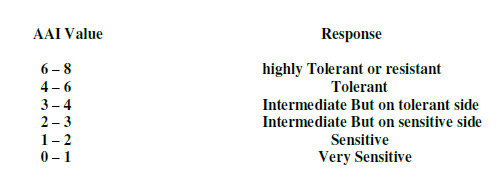 |
| VTPS: Vijayawada super thermal power station is on the outskirts of Vijayawada in Ibrahimpatnam. Total capacity of the station is 1760 MW. For Indian coal with 42% ash and 12% volatile matter, the rate is 350 MT/Hr of coal for 500 MW unit. 500 MW unit is produced by 350 MT of coal. For 1760 MW units the coal used is 1760*350/500 = 1232 MT of coal. |
| Coal fired plants are also a major source of emissions for several criteria of air pollutants including sulfur dioxide, oxides of nitrogen and particulate matter. Energy requirements for the developing countries in particular are met from coal-based thermal power plants. Coal is the single source of carbon dioxide emission in India. According to the current trends about 60% of the commercial energy consumption in the country is derived from coal. The physico-geographical conditions point out that the dispersion of air pollutants in Vijayawada surrounded by hills on all sides (complex terrain) is also poor. Further the heat island intensities are also more resulting in recirculation of air borne pollutants, this results in the increase in the concentration of air pollutants. The dust pollution because of heat and turbulence coupled with the operations leading to construction of new roadways is also resulting in increase of particulate pollutants at certain local centers. Vijayawada surrounded by hills appear like a basin in which the polluted air churns round increasing their concentration. Photosynthetic activity is directly dependent on carbon dioxide in the air, chlorophyll in vegetation water and nutrients coming through root system. In the presence of sun light photosynthetic activity absorbs carbon in the form of carbon dioxide of the atmosphere there by releasing oxygen into the atmosphere. Thus vegetation absorbs carbon (carbon sink) and releases oxygen into the atmosphere in other words vegetation through its photosynthetic activity cleanses the atmosphere from carbon dioxide. Based on the Ascorbic Acid new index (AAI) values, the plants were conveniently grouped as follows. |
 |
III. RESULTS AND DISCUSSIONS |
| Ascorbic Acid is most abundant anti oxidant in plants. It is essential for human and plant nutrition. In recent past research on ascorbic acid metabolism and function in plants has greatly increased. Metabolic engineering of ascorbate, biosynthesis to produce plants with increased ascorbate concentration, will not only provide crops with improved nutritional value, but will improve their growth and stress resistance in other words they are drought resistant, pollution resistant which consequently increase the yield. Plants are the major sources of ascorbic acid and other “nutriceutical” anti oxidants such as flavonoids and cerotinoids (Nicholas Smirnoff – 2000). Ascorbic acid plays a significant role in light reaction of photo synthesis (Singh and Verma – 2007) activates defense mechanism (Arora et.al., - 2002) and under stress condition, it can replace water from light reaction II (Singh and Verma – 2007). Ascorbic acid a natural anti oxidant in plants has been shown to play an important role in pollution tolerance (Joshi and Swamy – 2007). Ascorbic acid plays a role in cell wall synthesis, defense and cell division. It is also a strong reducer and plays important role in photo synthetic carbon fixation, with the reducing power directly proportional to its concentration. So the role of ascorbic acid is highlighted by Seyyednjad et.al., - 2011 and has been given top priority and used as a multiplication factor in air pollution tolerance index. So the scientific workers equivocally emphasized that ascorbic acid is the important parameter determining the tolerance increase to air pollution. In other words, the important parameter in determining air pollution tolerance of plants is ascorbic acid. So ascorbic acid is taken as an index in order to get a non dimensional index of ascorbic acid. All the values are divided by the minimum value of ascorbic acid which is in Antigonum leptopus (2.2), and the index is observed varying between 1 and 8. The present index is relatively simple because it can be determined by determining ascorbic acid level treating other parameters constant. (Total chlorophyll, Ph value, relative water content). |
| AAI = ascorbic acid in a sample / ascorbic acid minimum |
| Ascorbic acid on ordinate and the plant species on the axis showed a variation 1 and 8. Keeping in view the AAI tolerance one can ascribe 0 to 1 as very sensitive, 1 to 2 as sensitive, 2 to 3 intermediate but on sensitive side, 3 to 4 is intermediate but on tolerant side, 4 to 6 is tolerant, 6 to 8 highly tolerant or resistant to air pollution. Based on the ascorbic acid new index (AAI) new index values the plants were conveniently grouped as follows: Now the question is what are the management options to optimize and even reduce the urban air pollution, it is already a known fact that vegetation plays an important role in control of urban air pollutant concentrations. It is desirable because the vegetative cover moderate the temperatures in Vijayawada. The peculiar physico-geographical conditions in Vijayawada with three canal systems and Krishna river will make it an ideal place to grow vegetation, as vegetation reacts with different air pollutants to a different degree. The ideal management option is to grow resistive varieties which can survive in air pollution increasing scenario and at the same time provide the much needed shade and moderate mainly the temperature in particular climate in general over the urban area. In fact there should be a panel of environmental experts who can advice properly so that the pollution is absorbed by the increased vegetative cover and the much needed oxygen is released and the climate is moderated. It is desirable to have the following steps. Delineate the vegetative species tolerant to air pollution and suitable to the soil and the surrounding climate of Vijayawada urban center to grow the vegetation in all places in Vijayawada, so that the vegetative cover is increased. The barren hillocks surrounding the city are responsible for the excessive radiation towards the city interior making it hot with higher temperatures so the first preventive step will be to cover the hills with suitable vegetation, Albizzia lebbacc, Delonix regia, Banyan and Ficus trees which grow on rocky soils should be encouraged to be planted in all surrounding hillocks. In Tirupati city the municipal corporation itself has envisaged a program to develop (haritha project 2001 to 2002) to develop trees on the road sides. Strict laws should be envisaged in all the urban centers so as to prevent the indiscriminate cutting and felling of trees. In this context it is worth mentioning that the junior author has envisaged on a research program to determine which plant species are sensitive, intermediatory or resistant to air pollution. |
 |
IV. CONCLUSIONS |
| The parameter that may decide the tolerance of plant to air pollution is ascorbic acid. Based on the ascorbic acid new index (AAI) values the plants were conveniently grouped as highly tolerant, tolerant, intermediatory and sensitive. The tree species which are highly tolerant with high ascorbic acid level namely Albizzia lebbacc, Delonix regia, Azadirecta indica and Ficus religiosa with stand high levels of pollution, hence can be used in green belt developments in industries which are major contributors for green house emissions. |
| The observations in this study suggest that plants have the potential to serve as excellent quantitative and qualitative indicators of pollution. Since bio monitoring of plants is an important tool to evaluate the impact of air pollution on plants the above highly tolerant species can be used as bio monitors of vehicular pollution stress. The tolerant tree species namely Terminalia catappa, Mangifera indica, Pongamia pinnata and Polyalthia longifolia can effectively be used in the air pollution amelioration purpose. |
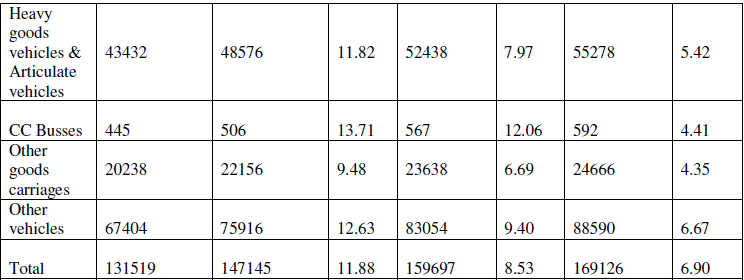 |
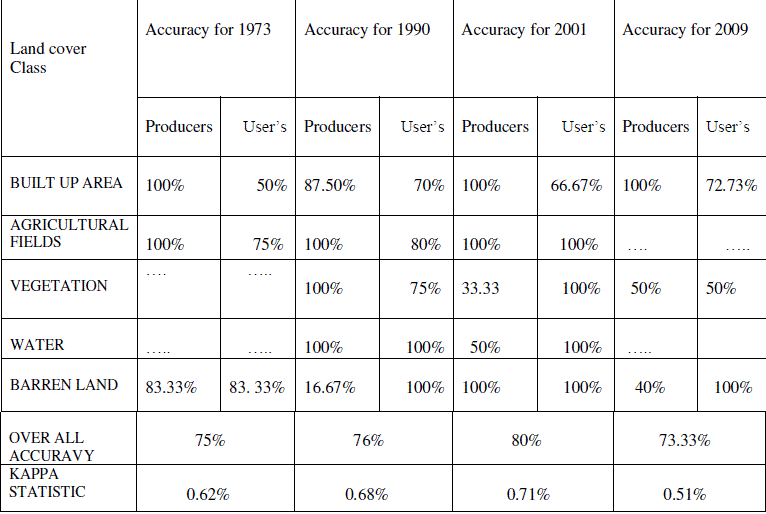 |
| Table – III Shows the conventional pollutants from V. T. P. S. power station are |
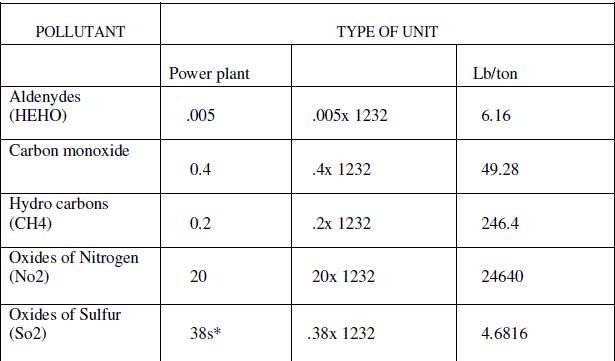 |
| Table 4: Plant species arranged in the decreasing order of their Ascorbic Acid index as per variety. |
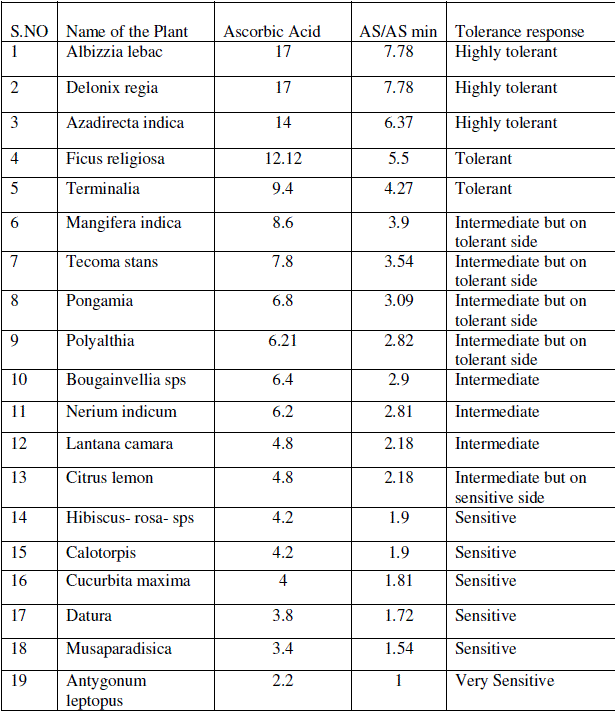 |
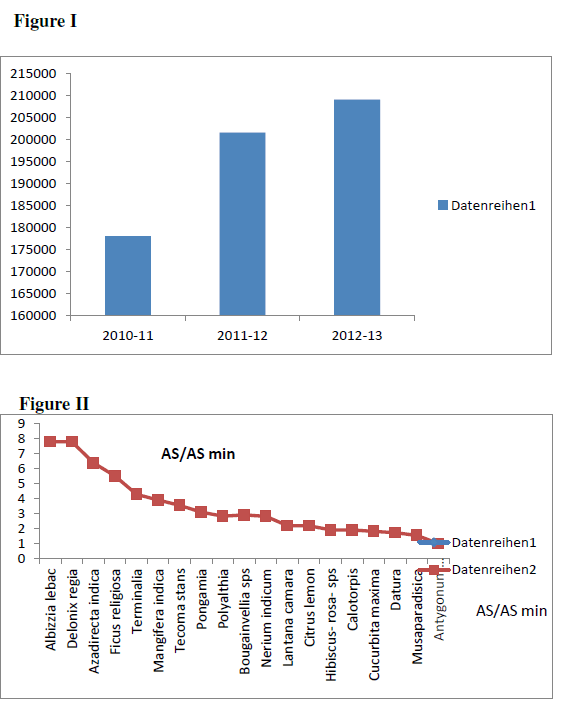 |
References |
|